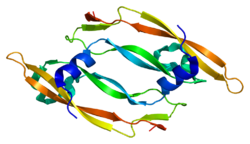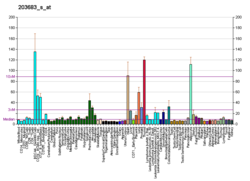Top Qs
Timeline
Chat
Perspective
Vascular endothelial growth factor B
Protein-coding gene in the species Homo sapiens From Wikipedia, the free encyclopedia
Remove ads
Vascular endothelial growth factor B also known as VEGF-B is a protein that, in humans, is encoded by the VEGF-B gene.[5] VEGF-B is a growth factor that belongs to the vascular endothelial growth factor family, of which VEGF-A is the best-known member.
Remove ads
Function
In contrast to VEGF-A, VEGF-B plays a less pronounced role in the vascular system: Whereas VEGF-A is important for the formation of blood vessels, such as during development or in pathological conditions, VEGF-B seems to play a role only in the maintenance of newly formed blood vessels during pathological conditions.[6] VEGF-B plays also an important role on several types of neurons. It is important for the protection of neurons in the retina[7] and the cerebral cortex during stroke,[8] and of motor neurons during motor neuron diseases such as amyotrophic lateral sclerosis.[9]
VEGF-B exerts its effects via the FLT1 receptor.[10] But the role of co-receptor NRP in VEGF-B-mediated effects is still unclear.[11]
VEGF-B has also been found to control endothelial uptake and transport of fatty acids in heart and skeletal muscle.[12][13]
Remove ads
Interactions
Vascular endothelial growth factor B has been shown to interact with FLT1, NRP1 and NRP2.[14][15][16][17]
References
Further reading
External links
Wikiwand - on
Seamless Wikipedia browsing. On steroids.
Remove ads






